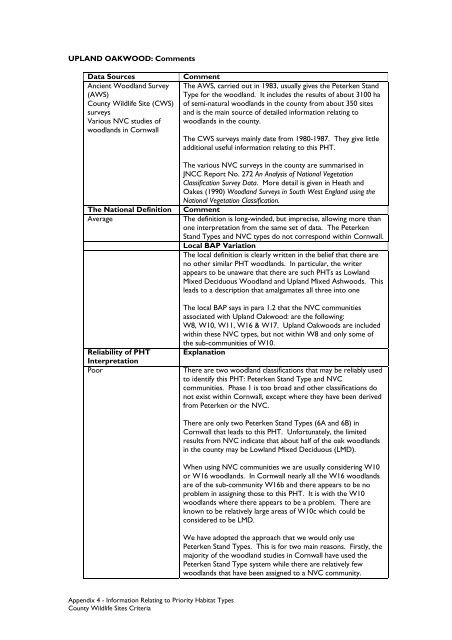County Wildife Site Criteria for Cornwall Appendices
County Wildife Site Criteria for Cornwall Appendices
County Wildife Site Criteria for Cornwall Appendices
You also want an ePaper? Increase the reach of your titles
YUMPU automatically turns print PDFs into web optimized ePapers that Google loves.
UPLAND OAKWOOD: CommentsData SourcesAncient Woodland Survey(AWS)<strong>County</strong> Wildlife <strong>Site</strong> (CWS)surveysVarious NVC studies ofwoodlands in <strong>Cornwall</strong>The National DefinitionAverageReliability of PHTInterpretationPoorCommentThe AWS, carried out in 1983, usually gives the Peterken StandType <strong>for</strong> the woodland. It includes the results of about 3100 haof semi-natural woodlands in the county from about 350 sitesand is the main source of detailed in<strong>for</strong>mation relating towoodlands in the county.The CWS surveys mainly date from 1980-1987. They give littleadditional useful in<strong>for</strong>mation relating to this PHT.The various NVC surveys in the county are summarised inJNCC Report No. 272 An Analysis of National VegetationClassification Survey Data. More detail is given in Heath andOakes (1990) Woodland Surveys in South West England using theNational Vegetation Classification.CommentThe definition is long-winded, but imprecise, allowing more thanone interpretation from the same set of data. The PeterkenStand Types and NVC types do not correspond within <strong>Cornwall</strong>.Local BAP VariationThe local definition is clearly written in the belief that there areno other similar PHT woodlands. In particular, the writerappears to be unaware that there are such PHTs as LowlandMixed Deciduous Woodland and Upland Mixed Ashwoods. Thisleads to a description that amalgamates all three into oneThe local BAP says in para 1.2 that the NVC communitiesassociated with Upland Oakwood: are the following:W8, W10, W11, W16 & W17. Upland Oakwoods are includedwithin these NVC types, but not within W8 and only some ofthe sub-communities of W10.ExplanationThere are two woodland classifications that may be reliably usedto identify this PHT: Peterken Stand Type and NVCcommunities. Phase 1 is too broad and other classifications donot exist within <strong>Cornwall</strong>, except where they have been derivedfrom Peterken or the NVC.There are only two Peterken Stand Types (6A and 6B) in<strong>Cornwall</strong> that leads to this PHT. Un<strong>for</strong>tunately, the limitedresults from NVC indicate that about half of the oak woodlandsin the county may be Lowland Mixed Deciduous (LMD).When using NVC communities we are usually considering W10or W16 woodlands. In <strong>Cornwall</strong> nearly all the W16 woodlandsare of the sub-community W16b and there appears to be noproblem in assigning those to this PHT. It is with the W10woodlands where there appears to be a problem. There areknown to be relatively large areas of W10c which could beconsidered to be LMD.We have adopted the approach that we would only usePeterken Stand Types. This is <strong>for</strong> two main reasons. Firstly, themajority of the woodland studies in <strong>Cornwall</strong> have used thePeterken Stand Type system while there are relatively fewwoodlands that have been assigned to a NVC community.Appendix 4 - In<strong>for</strong>mation Relating to Priority Habitat Types<strong>County</strong> Wildlife <strong>Site</strong>s <strong>Criteria</strong>
















